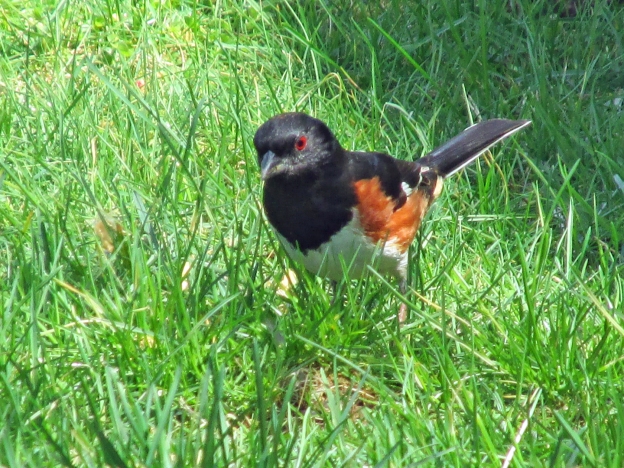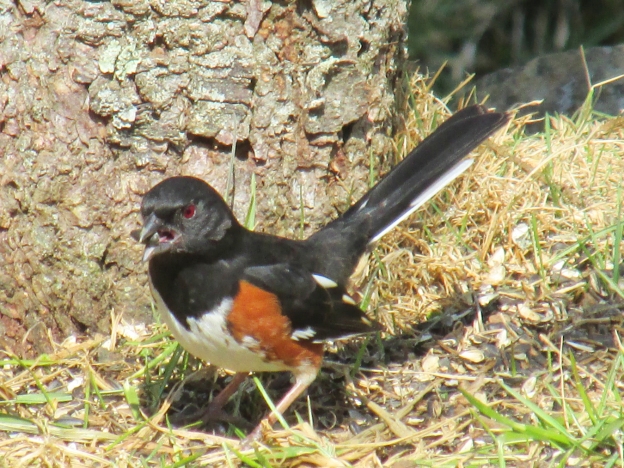It’s the time of year when young birds start making their first forays to feeders, usually accompanied by their parents and siblings. In recent weeks, I’ve seen everything from young brown thrashers and tufted titmice to ruby-throated hummingbirds and Eastern bluebirds.
Ann Windsor posted an interesting photo on my Facebook page last month that illustrates this emergence of a new generation of feathered friends. Her photo showed a male Eastern towhee escorting one of his offspring to a feeder on the deck of Ann’s home in Selmer, Tennessee.
Her post followed up a video she had posted of a pair of towhees visiting her feeder.
“I wanted to share with you about our towhee bird,” Ann noted in her post. “We call him ‘pretty boy,’ and he has been coming to our feeder now for two years or more.”
Back in early June, the male towhee showed up with a female for the first time. “She was more comfortable around us and got in the feeder with him,” Ann wrote. “We have so enjoyed him.”
Ann has made some interesting observations about the male towhee. “When he is in the little feeder dish, he’s the boss,” she wrote. “Any other birds come along, even the blue jays, and he runs them off.”

Photo by Pixabay.com • Female Eastern towhees are retain the male’s white and rusty-orange plumage, but they are brown instead of black like their male counterparts.
Ann’s day-to-day encounters with the towhees has turned into a “fun relationship” as the birds have learned to trust her enough that they don’t fly away when she’s in the yard.
I mentioned in a response to her first posting that the towhees would likely bring their young to her feeders once they left the nest. Indeed, about a month later, Ann posted another photo. In this particular picture, the male towhee arrives at the feeder with one of his recently fledged young.
“We have seen three so far,” Ann noted. She added that the young towhee in the photo loves to get up in one of the flower pots and dig around.
“I was wondering, as the young ones grow up, do they stay in the area, or do they go off to find their own territory?” Ann asked at the end of her post.
In my response, I told Ann that many birds have fidelity to the place where they were born, but things could get crowded if the adult birds also stay put. The parent towhees will probably “encourage” the young birds to strike out on their own and establish their own territories as adults. They might, however, become “neighbors” and choose a location not too far from her home.
Eastern towhees spend a considerable amount of time on the ground and hidden in thickets and hedges. Other common names for this bird includes “ground robin” and “swamp robin.” They are one of the larger members of the sparrow family, however, and not related to the thrush family, which includes such birds as American robin, Eastern bluebird and wood thrush.
Unlike the many “brown” members of the sparrow family, the Eastern Towhee is a brightly colored bird. Males have a black hood. The black coloration extends into the back and tail. The belly is white, and the sides are flanked with a rusty-red orange. In flight, their black tails are bordered with white feathers, which produces a dramatic flash of contrasting colors. The female Eastern Towhee is an attractive bird in her own right. She shares the rufous sides and white coloration that are present in the male’s plumage. However, the male’s black feathers are replaced by a warm, chocolate brown plumage in the female.

Photo by Bryan Stevens • A young Eastern Towhee visits a feeder in July. The chance to see young birds is a great reason to offer food during the summer, but some precautions should be taken to minimize uninvited guests.
The Eastern towhee is one of my favorite yard birds, but not just because of its dramatic appearance. These birds also have some instantly recognizable vocalizations. With the arrival of spring, the males will seek elevated perches for extensive singing bouts to attract mates and establish territories. Their song has been interpreted, quite aptly, as “Drink your tea!” They also have some alarm notes, such as “Chew-ink” and “Toe-Hee,” which is the basis for this bird’s common name.
The sparrows known as towhees are spread across two different genuses and consist of Abert’s towhee, California towhee and canyon towhee in the Melozone genus and the Eastern towhee, spotted towhee, green-tailed towhee, and collared towhee in the genus Pipilo. The genus name Pipilo is derived from Latin and roughly translates as “the chirping bunting.”
Keep watching your feeders. At this time of year, they provide one of the best venues for observing quality family time among our feathered friends.













